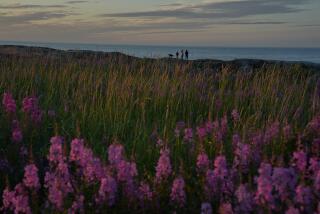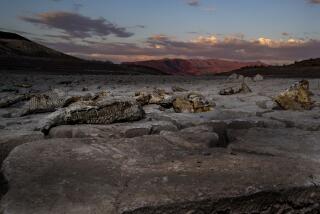Dust Bowl of ‘30s Returns to Western Canada
GLENTWORTH, Canada — Their fathers and grandfathers were homesteaders on the treeless grasslands of the northern prairies, where life has never been easy.
But old-timers on the farms and ranches of western Canada’s grain belt say the current drought affecting 45 million acres of southern Saskatchewan and Alberta is the worst since the dust bowl of the 1930s.
“People went out of here in wagons in the Dirty ‘30s--I saw ‘em,” said Ernest Fortnum, 76, who was born and raised in the hamlet of Glentworth, where there hasn’t been a decent rain since a soaking, 2-day downpour last Aug. 16-17.
Fields where foot-high spring wheat should be dancing in the wind lie uncultivated or stunted with seedlings searching for moisture. Only the stubble from last year’s crop prevents topsoil from blowing away.
Cattle Moved North
In a migration path cowboys once rode, ranchers are moving their cattle north to 87 federal pastures outside the drought area, while others are selling newborn calves rather than pay the U.S. equivalent of $82 a ton for hay, more than double the normal price.
“When you go over your land with a big machine, you just leave gunpowder. It’s like the desert,” said Fortnum, whose father emigrated from England in 1905. The family tree includes the founder of Fortnum & Mason’s food emporium in London.
To qualify for government crop insurance, Fortnum has seeded all but 800 acres of his 4,000-acre spread with durum wheat, burying the kernels in the dust and watching the plants struggle to germinate.
“It’s going to die pretty soon. We get day after day of this,” he said as a hot, hard wind swept over a province that boasts 46%of Canada’s farmland and 54%of its grain exports.
Crisis Began in ’84
Canada is the world’s second-largest wheat exporter, after the United States.
The crisis, covering 60%of the wheat belt, began with abnormally dry years in 1984 and 1985. There was no rain last fall, followed by a snowless winter, which affected Calgary’s Winter Olympics, and a dry spring with none of the usual run-off.
Things got worse in early June when record temperatures above 100 degrees dried up reservoirs and wells. Thousands of chickens perished.
Old Wives Lake, a 12-mile-wide expanse south of Moose Jaw, is bone dry for the first time since 1937. Like white paint, a salty residue is all that is left.
Limited Relief
Recently, after the spiritual leader of Alberta’s Blood Indians, Wallace Mountain Horse, camped out in a thunder tepee to pray for rain, scattered thundershowers brought the first limited relief.
But the storms took a toll. Accompanying winds whipped dusty topsoil away in clouds, while lightning ignited a grain elevator in Biggar, Saskatchewan, causing $1.6 million worth of damage.
Saskatchewan Premier Grant Devine, who still works 1,000 acres near Moose Jaw, said he may be among those deprived of a crop this year. “We’re halfway there now,” he said.
Provincial and federal handouts should protect most of the 80,000 affected farms and 2 million head of cattle, he said, with programs ranging from grants for digging wells to insurance covering about 70%of a lost crop. Farmers say at worst they will break even.
Plentiful Grasshoppers
Despite the dryness, grasshoppers are hatching in the millions.
“You have to spray in case it does rain and there’s a chance for a crop,” said Robert Carignan, 38, who farms 2,700 acres in Ponteix, Saskatchewan, where drought deprived him of harvests in 1961 and 1984.
Carignan said nothing will drive him from the land his French-Canadian grandfather settled in 1906. “Life goes on, eh?” he said.
In nearby Vanguard, neighbors gathered at Guy Seto’s Chinese lunchroom as a thunderstorm brought the first light rain in 10 months. “If you can’t be optimistic, you shouldn’t try farming,” said 82-year-old Ralph Kuhlmann, whose father came north from Iowa in 1909 and decided to stay.
Land Prices Down
Even if you want to sell out, there aren’t any buyers, added Welly Graham. Land that fetched $820 an acre a decade ago now goes begging at a third that price.
“People will stick it out,” Graham said. “In the city, you fight traffic and don’t even know what the climate is.”
As Premier Devine put it: “We probably won’t grow watermelon. But don’t write off the West because we have a drought.”
More to Read
Sign up for Essential California
The most important California stories and recommendations in your inbox every morning.
You may occasionally receive promotional content from the Los Angeles Times.










